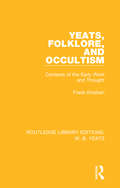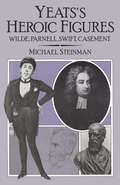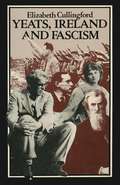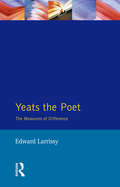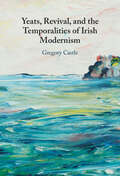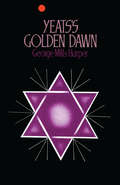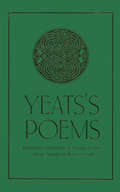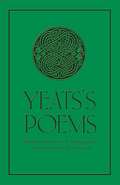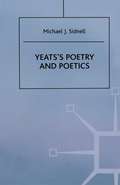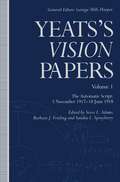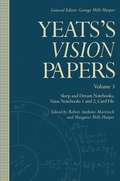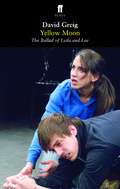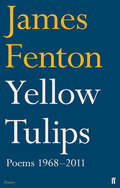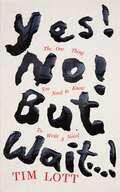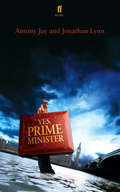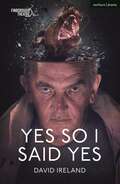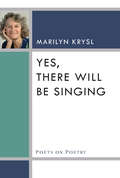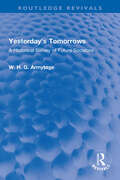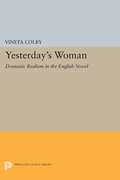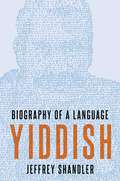- Table View
- List View
Yeats, Folklore and Occultism: Contexts of the Early Work and Thought (Routledge Library Editions: W. B. Yeats)
by Frank KinahanThis lively introduction to the poems of W. B. Yeats, first published in 1988, provides a series of intriguing new readings of his work in relation to his profound involvement with occultism and folklore. During Yeats’s formative years as an artist, two compelling movements were emerging: the revivals of interest in Irish folklore and in the mag
Yeats The Poet: The Measures of Difference
by Edward LarrissyThis work addresses Yeats's "antinomies", seeing their origin and structure in his divided Anglo-Irish inheritance and examining the notion of measure. It then explores how this relates to freemasonry, Celticism and Orientalism and looks at the Blakean esoteric language of contrariety and outline which provided Yeats with the vocabulary of self-understanding.
Yeats The Poet: The Measures of Difference
by Edward LarrissyThis work addresses Yeats's "antinomies", seeing their origin and structure in his divided Anglo-Irish inheritance and examining the notion of measure. It then explores how this relates to freemasonry, Celticism and Orientalism and looks at the Blakean esoteric language of contrariety and outline which provided Yeats with the vocabulary of self-understanding.
Yeats, Revival, and the Temporalities of Irish Modernism
by null Gregory CastleYeats, Revival, and the Temporalities of Irish Modernism offers a new understanding of a writer whose revivalist commitments are often regarded in terms of nostalgic yearning and dreamy romanticism. It counters such conventions by arguing that Yeats's revivalism is an inextricable part of his modernism. Gregory Castle provides a new reading of Yeats that is informed by the latest research on the Irish Revival and guided by the phenomenological idea of worldmaking, a way of looking at literature as an aesthetic space with its own temporal and spatial norms, its own atmosphere generated by language, narrative, and literary form. The dialectical relation between the various worlds created in the work of art generate new ways of accounting for time beyond the limits of historical thinking. It is just this worldmaking power that links Yeats's revivalism to his modernism and constructs new grounds for recognizing his life and work.
Yeats’s Golden Dawn: The Influence Of The Hermetic Order Of The Golden Dawn On The Life And Art Of W.b. Yeats
by George Mills HarperYeats's Legacies: Yeats Annual No. 21 (Yeats Annual Ser. #Vol. 21)
by Warwick GouldThe two great Yeats Family Sales of 2017 and the legacy of the Yeats family’s 80-year tradition of generosity to Ireland’s great cultural institutions provide the kaleidoscope through which these advanced research essays find their theme. Hannah Sullivan’s brilliant history of Yeats’s versecraft challenges Poundian definitions of Modernism; Denis Donoghue offers unique family memories of 1916 whilst tracing the political significance of the Easter Rising; Anita Feldman addresses Yeats’s responses to the Rising’s appropriation of his symbols and myths, the daring artistry of his ritual drama developed from Noh, his poetry of personal utterance, and his vision of art as a body reborn rather than a treasure preserved amid the testing of the illusions that hold civilizations together in ensuing wars. Warwick Gould looks at Yeats as founding Senator in the new Free State, and his valiant struggle against the literary censorship law of 1929 (with its present-day legacy of Irish anti-blasphemy law still presenting a constitutional challenge). Drawing on Gregory Estate documents, James Pethica looks at the evictions which preceded Yeats’s purchase of Thoor Ballylee in Galway; Lauren Arrington looks back at Yeats, Ezra Pound, and the Ghosts of The Winding Stair (1929) in Rapallo. Having co-edited both versions of A Vision, Catherine Paul offers some profound reflections on ‘Yeats and Belief’. Grevel Lindop provides a pioneering view of Yeats’s impact on English mystical verse and on Charles Williams who, while at Oxford University Press, helped publish the Oxford Book of Modern Verse. Stanley van der Ziel looks at the presence of Shakespeare in Yeats’s Purgatory. William H. O’Donnell examines the vexed textual legacy of his late work, On the Boiler while Gould considers the challenge Yeats’s intentionalism posed for once-fashionable post-structuralist editorial theory. John Kelly recovers a startling autobiographical short story by Maud Gonne. While nine works of current biographical, textual and literary scholarship are reviewed, Maud Gonne is the focus of debate for two reviewers, as are Eva Gore-Booth, Constance and Casimir Markievicz, Rudyard Kipling, David Jones, T. S. Eliot and his presence on the radio.
Yeats's Legacies: Yeats Annual No. 21 (Yeats Annual #21)
by Warwick GouldThe two great Yeats Family Sales of 2017 and the legacy of the Yeats family’s 80-year tradition of generosity to Ireland’s great cultural institutions provide the kaleidoscope through which these advanced research essays find their theme. Hannah Sullivan’s brilliant history of Yeats’s versecraft challenges Poundian definitions of Modernism; Denis Donoghue offers unique family memories of 1916 whilst tracing the political significance of the Easter Rising; Anita Feldman addresses Yeats’s responses to the Rising’s appropriation of his symbols and myths, the daring artistry of his ritual drama developed from Noh, his poetry of personal utterance, and his vision of art as a body reborn rather than a treasure preserved amid the testing of the illusions that hold civilizations together in ensuing wars. Warwick Gould looks at Yeats as founding Senator in the new Free State, and his valiant struggle against the literary censorship law of 1929 (with its present-day legacy of Irish anti-blasphemy law still presenting a constitutional challenge). Drawing on Gregory Estate documents, James Pethica looks at the evictions which preceded Yeats’s purchase of Thoor Ballylee in Galway; Lauren Arrington looks back at Yeats, Ezra Pound, and the Ghosts of The Winding Stair (1929) in Rapallo. Having co-edited both versions of A Vision, Catherine Paul offers some profound reflections on ‘Yeats and Belief’. Grevel Lindop provides a pioneering view of Yeats’s impact on English mystical verse and on Charles Williams who, while at Oxford University Press, helped publish the Oxford Book of Modern Verse. Stanley van der Ziel looks at the presence of Shakespeare in Yeats’s Purgatory. William H. O’Donnell examines the vexed textual legacy of his late work, On the Boiler while Gould considers the challenge Yeats’s intentionalism posed for once-fashionable post-structuralist editorial theory. John Kelly recovers a startling autobiographical short story by Maud Gonne. While nine works of current biographical, textual and literary scholarship are reviewed, Maud Gonne is the focus of debate for two reviewers, as are Eva Gore-Booth, Constance and Casimir Markievicz, Rudyard Kipling, David Jones, T. S. Eliot and his presence on the radio.
Yeats’s Poems
by Warwick GouldWilliam Butler Yeats is considered Ireland's greatest poet. He is one of the most significant literary figures of the twentieth century. He was awarded the Nobel Prize for Literature in 1923. This is the definitive collection of his poems, encompassing the full range of his powers, from the love lyrics to the political poems, from poems meditating on the bliss of youth, to the verse that rails against old age. A detailed notes section and full appendix provide an invaluable key to the poems as well as biographical information on the life of the poet and a guide to his times. The collection includes Yeats's fourteen books of lyrical poems, his narrative and dramatic poetry, and his own notes on individual poems.
Yeats’s Poems
by W. B. YeatsHere in one volume is the entire canon of Yeat's verse, who was awarded the Nobel Prize for Literature in 1923. He was a poet and playwright, storyteller and visionary. The author also wrote "Yeats: Man and Poet".
Yeats’s Poetry and Poetics
by Michael J. SidnellYeats's Poetry and Poetics brings together some of the finest Yeats criticism ever published, together with some new pieces specially written for this volume. Spanning the whole of Yeats's career, the essays are organised into three main parts. The first deals with Yeats's concern with the speaking voice and its bearing on public and private readings of his verse; and on his use of certain kinds of images in his poetry and plays, from ghosts and fairies, to figures borrowed from painters and sculptors and, extraordinarily, to the actual dancer for whom he makes room in his work. The second section puts Yeats's poetry in context with the work of Synge, D.H. Lawrence, Walter de la Mare and other 'Georgians', and with that of T.S. Eliot and other modernists; assessing the continuities (real and asserted) in Yeats's long poetic career against the revolutions in the poetry of his time. The profound connections between the writings of Yeats and Joyce, including the coupling of Finnegans's Wake and 'The Wanderings of Oisin' are also examined. Rounding off the volume 'Phantasmagoria', explores the implications for his poetics of Yeats's spiritualist philosophy, especially in terms of his conception of the poetic self, and, finally, the last section analyses two works animated by Yeats's quest for the 'faery bride' and his desperate attempt to attract, through his work, a real one.
Yeats's "Vision" Papers: The Automatic Script - 5 November, 1917 to 23 September, 1918 (Yeats's 'Vision' Papers)
by W. B. YeatsThe first volume of a three-volume edition of the collected papers and notebooks which comprise the "automatic writing" of W.B.Yeats. This material, which spans the years between 1917 and 1920, contains Yeats' thoughts concerning literature and art, which in turn, comprises his "vision".
Yeats’s Vision Papers: Volume 3: Sleep and Dream Notebooks, Vision Notebooks 1 and 2, Card File (Yeats's 'Vision' Papers)
by W. B. YeatsThe third volume of a three volume edition of the collected papers and notebooks which comprise the "automatic writing" of W.B.Yeats. The material presented here is taken from the writings known as "the sleep and dreams" notebooks, the "vision" notebooks one and two and from Yeats' card files.
Yellow Moon: The Ballad Of Leila And Lee
by David GreigYellow Moon is a modern Bonnie and Clyde tale that follows the fortunes of two teenagers on the run. Silent Leila is an introverted girl who has a passion for celebrity magazines. Stag Lee Macalinden is the deadest of dead-end kids in a dead-end town. They never meant to get mixed up in a murder... but now they need a place to hide.Yellow Moon explores what it means to live in a celebrity-obsessed world and what it is that defines who you are when you're 17 years old. The play premiered at the Circle Studio of Citizens' Theatre, Glasgow, in September 2006, and won the 2008 Brain Way Award for Best Play for Young People.
Yellow Tulips: Poems 1968–2011
by James FentonWinner of both the Queen's Gold Medal and the Whitbread Prize for Poetry, James Fenton has given readers some of the most memorable lyric verse of the past decades, from the formal skill that marked his debut, Terminal Moraine, to the dramatic and political monologues of The Memory of War and Children in Exile, through to the unforgettable love poems of Out of Danger and his most recent work: Poems is an essential selection by, as Stephen Spender put it, 'a brilliant poet of technical virtuosity'.Don't talk to me of love. I've had an earfulAnd I get tearful when I've downed a drink or two.I'm one of your talking wounded.I'm a hostage. I'm maroonded.But I'm in Paris with you.From 'In Paris With You' by James Fenton
Yes! No! But Wait...!: The One Thing You Need to Know To Write a Novel
by Tim LottAt the heart of writing – at the apex of storytelling – there is only one principle, and it winds like a golden thread across all the books and courses. But it gets lost in the ever-spreading panoply of detail that the creative writing industry relies on to keep its wheels turning. This book pulls out that thread, polishes it and reveals the way it penetrates storytelling. It will be invaluable to anyone creating fictional worlds - but most particularly to novelists, who are most in danger of forgetting it. Or not noticing it in the first place. Tim Lott knows he can’t teach anyone to write a novel (that’s one of the lies propagated by the novel-writing industry). But he can teach someone how to build a firm platform on which they can stand in order to explore whether they have the talent, will and determination that writing a novel takes.
Yes Prime Minister: a play
by Antony Jay Jonathan LynnYes, Minister, and the equally successful sequel Yes, Prime Minister captured a niche in the political consciousness of the nation. First broadcast thirty years ago, the original writers of these classic series have reunited to create a bang up to date Yes, Prime Minister for the stage. Spin, blackberries, sexed-up dossiers, sleaze, global warming and a country on the brink of financial meltdown form the backdrop to mayhem at Chequers as the Foreign Minister of Kumranistan makes a seriously compromising offer of salvation. Prime Minister Jim Hacker remains in power with his coterie of close advisors including Cabinet Secretary Sir Humphrey Appleby and Principal Private Secretary Bernard Woolley, but for how long? They govern a whole new world. Yes, Prime Minister premiered in the Festival Theatre, Chichester, in May 2010.
Yes So I Said Yes (Modern Plays)
by David IrelandIt's harder to kill people when there's a peace process on.Ulster Loyalist Alan Black is kept awake every night by his neighbour McCorrick's dog barking. To add to his difficulties, McCorrick refuses to acknowledge that he even owns a dog, let alone one that is creating a disturbance.In a Northern Ireland he barely recognises, where politics has proved just to be the continuation of war by other means, a disconsolate Alan sets out to rid himself of the incessant noise. As he seeks help from authority figures, he finally – as a very last resort – turns to the only voice he can really trust, Eamonn Holmes…Coinciding with the 100th anniversary of the partition of Ireland and the foundation of Northern Ireland, Yes So I Said Yes is a blackly comic, ferocious, dystopian satire about what it's like to feel alone in a place where everyone else is conspiring to erase you and your history.This edition was published to coincide with the production at London's Finborough Theatre in November 2021.
Yes So I Said Yes (Modern Plays)
by David IrelandIt's harder to kill people when there's a peace process on.Ulster Loyalist Alan Black is kept awake every night by his neighbour McCorrick's dog barking. To add to his difficulties, McCorrick refuses to acknowledge that he even owns a dog, let alone one that is creating a disturbance.In a Northern Ireland he barely recognises, where politics has proved just to be the continuation of war by other means, a disconsolate Alan sets out to rid himself of the incessant noise. As he seeks help from authority figures, he finally – as a very last resort – turns to the only voice he can really trust, Eamonn Holmes…Coinciding with the 100th anniversary of the partition of Ireland and the foundation of Northern Ireland, Yes So I Said Yes is a blackly comic, ferocious, dystopian satire about what it's like to feel alone in a place where everyone else is conspiring to erase you and your history.This edition was published to coincide with the production at London's Finborough Theatre in November 2021.
Yes, There Will Be Singing: Yes, There Will Be Singing (Poets On Poetry)
by Marilyn KryslYes, There Will Be Singing brings together Marilyn Krysl’s essays on the origins of language and poetry, poetic form, the poetry of witness, and poetry’s collaboration with the healing arts. Beginning with pieces on her own origins as a poet, she branches into poetry’s profound spiritual and political possibilities, drawing on rich examples from poets such as Anna Akhmatova, W.S. Merwin, and Vénus Khoury-Ghata. Krysl concludes with a selection of stories of her nursing and humanitarian work, powerfully connecting poetic expression with a generous and compassionate worldview.
Yesterday's Tomorrows: A Historical Survey of Future Societies (Routledge Revivals)
by W. H. ArmytageFirst published in 1968, Yesterday’s Tomorrows elucidates on the favourite occupation of man: forecasting the future. By man’s predictions, he mirrors his own wish-fulfilments, displacements, projections, denials, evasions and withdrawals. These predications can take the form of countries of the imagination, ‘mirror worlds’ like Rabelais’ Ever-Ever lands or the Erewhon of Butler. Alternatively, they may spring from panic, reflecting fear rather than hope, often manifesting themselves, in our technological age, as reports of ‘flying saucers’ or invasions from another planet. In either form, they provide philosophers, scientists, doctors and sociologists with material for evaluating man’s future needs, offering both criticism of our present society, plans for our future, and release from tension and disequilibrium. Professor Armytage shows in this book how such ‘visions’ can, and do, refresh minds for renewed grappling with the present by arming them with ideas for man’s future needs. He indicates that, out of an apparent welter of futuristic fantasies, a constructive debate about tomorrow is emerging, providing us with operational models of what tomorrow could be. This book will hold special interest for students of philosophy and of English literature.
Yesterday's Tomorrows: A Historical Survey of Future Societies (Routledge Revivals)
by W. H. ArmytageFirst published in 1968, Yesterday’s Tomorrows elucidates on the favourite occupation of man: forecasting the future. By man’s predictions, he mirrors his own wish-fulfilments, displacements, projections, denials, evasions and withdrawals. These predications can take the form of countries of the imagination, ‘mirror worlds’ like Rabelais’ Ever-Ever lands or the Erewhon of Butler. Alternatively, they may spring from panic, reflecting fear rather than hope, often manifesting themselves, in our technological age, as reports of ‘flying saucers’ or invasions from another planet. In either form, they provide philosophers, scientists, doctors and sociologists with material for evaluating man’s future needs, offering both criticism of our present society, plans for our future, and release from tension and disequilibrium. Professor Armytage shows in this book how such ‘visions’ can, and do, refresh minds for renewed grappling with the present by arming them with ideas for man’s future needs. He indicates that, out of an apparent welter of futuristic fantasies, a constructive debate about tomorrow is emerging, providing us with operational models of what tomorrow could be. This book will hold special interest for students of philosophy and of English literature.
Yesterday's Woman: Domestic Realism in the English Novel
by Vineta ColbyEncouraged by the response of the avid novel-reading public in early nineteenth-century England, minor novelists produced a staggering number of volumes that shaped styles, formed attitudes, and gave to the novel a new status and respectability. These novels were read by both sexes, but the majority were written by women. Vineta Colby examines the works of such minor novelists as Mrs. Gore, Maria Edgeworth, Charlotte Yonge, and Harriet Martincau, arguing that they prepared the way for the novels of the great Victorian era.Antiromantic and bourgeois in spirit, these domestic novels were concerned with daily living in ordinary society. As the form developed, the novels turned away from "idle romance" to a serious treatment of basic questions of human and social values. Professor Colby demonstrates how the preoccupation with high society, childhood, and village life laid the thematic foundations for the more sophisticated works of the later Victorians. The author concludes by showing that the disruption of the family unit by technology, urbanization, and scientific materialism led the domestic novel into the realms of literary naturalism and social realism.Originally published in 1974.The Princeton Legacy Library uses the latest print-on-demand technology to again make available previously out-of-print books from the distinguished backlist of Princeton University Press. These editions preserve the original texts of these important books while presenting them in durable paperback and hardcover editions. The goal of the Princeton Legacy Library is to vastly increase access to the rich scholarly heritage found in the thousands of books published by Princeton University Press since its founding in 1905.
Yiddish: Biography of a Language
by Jeffrey ShandlerThe most widely spoken Jewish language on the eve of the Holocaust, Yiddish continues to play a significant role in Jewish life today, from Hasidim for whom it is a language of daily life to avant-garde performers, political activists, and LGBTQ writers turning to Yiddish for inspiration. Yiddish: Biography of a Language presents the story of this centuries-old language, the defining vernacular of Ashkenazi Jews, from its origins to the present. Jeffrey Shandler tells the multifaceted history of Yiddish in the form of a biographical profile, revealing surprising insights through a series of thematic chapters. He addresses key aspects of Yiddish as the language of a diasporic population, whose speakers have always used more than one language. As the vernacular of a marginalized minority, Yiddish has often been held in low regard compared to other languages, and its legitimacy as a language has been questioned. But some devoted Yiddish speakers have championed the language as embodying the essence of Jewish culture and a defining feature of a Jewish national identity. Despite predictions of the demise of Yiddish-dating back well before half of its speakers were murdered during the Holocaust-the language leads a vibrant, evolving life to this day.
